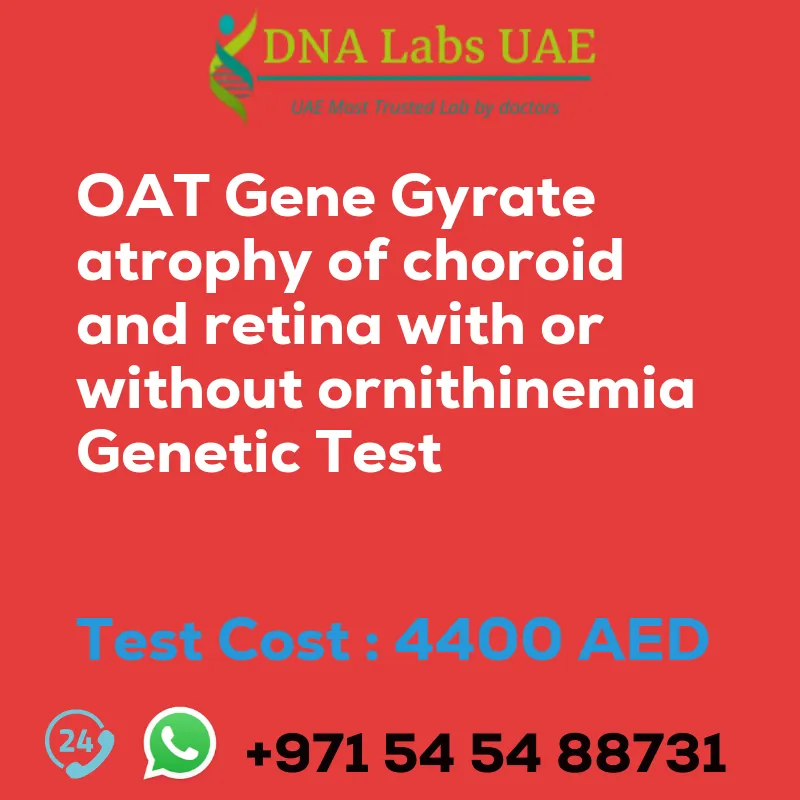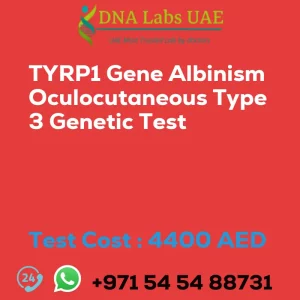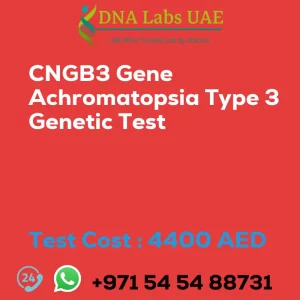OAT Gene Gyrate Atrophy of Choroid and Retina with or without Ornithinemia Genetic Test
Are you or someone you know experiencing progressive vision loss? It could be a result of gyrate atrophy of the choroid and retina with or without ornithinemia. This rare genetic disorder can be diagnosed through a genetic test called the OAT Gene Gyrate Atrophy of Choroid and Retina with or without Ornithinemia Genetic Test.
Test Details
The OAT gene is associated with gyrate atrophy of the choroid and retina with or without ornithinemia. This disorder is characterized by the degeneration of the retina and choroid, leading to progressive vision loss. It is caused by a deficiency of the enzyme ornithine aminotransferase (OAT), which is responsible for breaking down the amino acid ornithine. Mutations in the OAT gene can result in a decrease or complete loss of OAT activity, leading to an accumulation of ornithine in the body and damage to the retina and choroid.
Test Components and Price
The OAT Gene Gyrate Atrophy of Choroid and Retina with or without Ornithinemia Genetic Test is available at DNA Labs UAE for a cost of 4400.0 AED. The test can be performed using blood or extracted DNA, or even just one drop of blood on an FTA card.
Report Delivery and Method
After undergoing the test, you can expect to receive your report within 3 to 4 weeks. The test is conducted using NGS (Next Generation Sequencing) technology, which allows for a comprehensive analysis of the OAT gene.
Test Type and Doctor
The OAT Gene Gyrate Atrophy of Choroid and Retina with or without Ornithinemia Genetic Test falls under the category of Ophthalmology Disorders. It is recommended to consult with an ophthalmologist for this test.
Test Department and Pre-Test Information
The test is conducted in the Genetics department. Prior to the test, it is important to provide the clinical history of the patient who will be undergoing the test. Additionally, a genetic counseling session may be conducted to create a pedigree chart of family members affected by the disorder.
Treatment and Management
If diagnosed with gyrate atrophy of the choroid and retina with or without ornithinemia, treatment may involve dietary restrictions of arginine and supplementation with vitamin B6. These measures can help reduce ornithine levels in the body and manage the disorder.
Don’t let progressive vision loss go undiagnosed. Take the OAT Gene Gyrate Atrophy of Choroid and Retina with or without Ornithinemia Genetic Test today and take control of your eye health.
| Test Name | OAT Gene Gyrate atrophy of choroid and retina with or without ornithinemia Genetic Test |
|---|---|
| Components | |
| Price | 4400.0 AED |
| Sample Condition | Blood or Extracted DNA or One drop Blood on FTA Card |
| Report Delivery | 3 to 4 Weeks |
| Method | NGS Technology |
| Test type | Ophthalmology Disorders |
| Doctor | Ophthalmologist |
| Test Department: | Genetics |
| Pre Test Information | Clinical History of Patient who is going for OAT Gene Gyrate atrophy of choroid and retina with or without ornithinemia NGS Genetic DNA Test. A Genetic Counselling session to draw a pedigree chart of family members affected with OAT Gene Gyrate atrophy of choroid and retina with or without ornithinemia NGS Genetic DNA Test gene OAT |
| Test Details |
The OAT gene is associated with a rare genetic disorder called gyrate atrophy of choroid and retina with or without ornithinemia. This disorder is characterized by progressive vision loss due to degeneration of the retina and choroid, which are important structures for vision. Ornithinemia refers to the presence of high levels of the amino acid ornithine in the blood, which is caused by a deficiency of the enzyme ornithine aminotransferase (OAT). The OAT gene provides instructions for making the OAT enzyme, which is involved in the breakdown of ornithine. Mutations in the OAT gene can result in a decrease or complete loss of OAT activity, leading to an accumulation of ornithine in the body. This accumulation can cause damage to the retina and choroid, leading to vision loss. NGS genetic testing can be used to identify mutations in the OAT gene that are associated with gyrate atrophy of choroid and retina with or without ornithinemia. This testing can help with diagnosis, genetic counseling, and management of the disorder. Treatment may involve dietary restriction of arginine and supplementation with vitamin B6, which can help to reduce ornithine levels in the body. |








